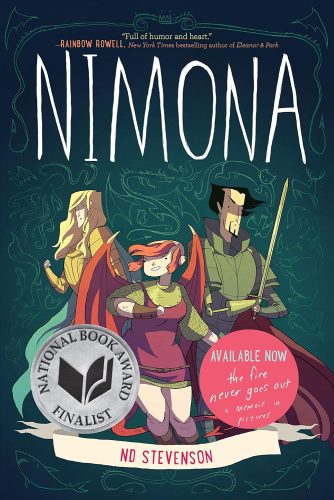 “I’m the villain. What do you suppose that says about you?”
“I’m the villain. What do you suppose that says about you?”
Author: ND Stevenson
Lord Ballister Blackheart is labeled a villain, but he is more in-line with a peace-loving activist. His supposedly malicious scheme – to reveal the lies of the Institute of Law Enforcement and how they are stockpiling and using poison on the people. Unfortunately for Blackheart, his ex-lover and the kingdom’s current golden boy, Sir Ambrosius Goldenloin, is in league with the corrupt institute. Taking one down will take the other down, and Blackheart is conflicted. That is, until a shapeshifting, violent, sidekick wanna-be storms her way into his home and sets the spark that will explode the kingdom, for good or evil.
Nimona is part dead-pan epic, part societal expose. The point is obvious: who we label heroes and villains is rarely based on truth, and what our governments and institutions and corporations are telling us is a curated, often false, representation of what is really going on. Also: dragons, death, dismemberment, and a kid (young adult?) with spiky hair and flexible morals is an awesome but dreadful sidekick for one conflicted villain to have.
While Blackheart still carries a torch for Goldenloin, who ended their relationship in the most terrible betrayal, and is willing to carry the lonely mantle of bad guy to do the right thing, Nimona just wants to kill lots and lots of people and make a big noise. She’s the “grey area” of the tale, and while she prods Blackheart into necessary action, her body count is also very, very high. We kind of love her, and kind of hate what she does. I mean really, everyone is expendable to her, and while it’s presented in a funny way, through her droll conversations with the usually taciturn Blackheart, it makes us uncomfortable too, which is, I expect, exactly what the author wanted.

Image by Clker-Free-Vector-Images from Pixabay
The plot shifts back and forth between funny and savagely prescient as Blackheart reveals the Institute’s schemes and sets his own underway, all while trying to control Nimona. Meanwhile, we learn a bit (mostly false) about Nimona’s own history and the meaning of the word “monster” and how its application and misuse can create the very creature it fears (you see where this is going, right?)
That’s right – more chaos and death in an ultimate showdown scene where everything is revealed and the true extent of Nimona’s truly endless powers are unveiled. Now, I haven’t seen the Netflix series, but apparently the book is darker and less hopeful than the series that follows it – an interesting choice since the author herself was deeply involved in crafting the screenplay for the TV series. But there are plenty of Internet articles out there that talk about that.
The only thing I didn’t like? The artwork. Honestly, I couldn’t stand it. It’s so sloppy, so filled with sharp angles and no details. It looks like something that would take mere seconds to make. It’s not my style. I just did not vibe with it at all, despite quite loving the story. Oddly enough, I do like the images I have seen from the Netflix series, so let that inform you as it will.
I’m not really a graphic novel reader for the most part, but I did honestly enjoy Nimona and recommended it to my husband, who adores comic books. Recommended, even if you’re not normally a graphic novel reader and even if, like me, this art style doesn’t call to you.
– Frances Carden
Follow my reviews on Twitter at: https://twitter.com/xombie_mistress
Follow my reviews on Facebook at: https://www.facebook.com/FrancesReviews
- Book Vs Movie: The Shining - April 6, 2020
- Thankful For Great Cozy Mysteries - December 13, 2019
- Cozy Mysteries for a Perfect Fall - October 20, 2019


